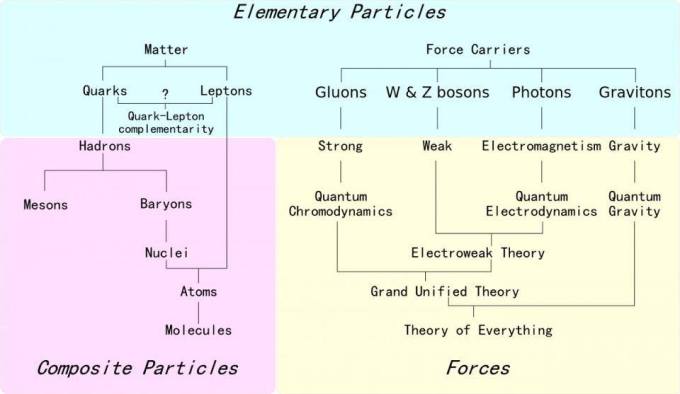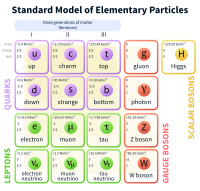Generations of matter
| Type | First | Second | Third |
|---|---|---|---|
| Quarks | |||
| up-type | up | charm | top |
| down-type | down | strange | bottom |
| Leptons | |||
| charged | electron | muon | tau |
| neutral | electron neutrino | muon neutrino | tau neutrino |
Fermions and bosons
Those particles with half-integer spins, such as 1/2, 3/2, 5/2, are known as fermions, while those particles with integer spins, such as 0, 1, 2, are known as bosons. The two families of particles obey different rules and broadly have different roles in the world around us. A key distinction between the two families is that fermions obey the Pauli exclusion principle; that is, there cannot be two identical fermions simultaneously having the same quantum numbers (meaning, roughly, having the same position, velocity and spin direction). In contrast, bosons obey the rules of Bose–Einstein statistics and have no such restriction, so they may “bunch together” even if in identical states. Also, composite particles can have spins different from their component particles. For example, a helium atom in the ground state has spin 0 and behaves like a boson, even though the quarks and electrons which make it up are all fermions.
This has profound consequences:
- Quarks and leptons (including electrons and neutrinos), which make up what is classically known as matter, are all fermions with spin 1/2. The common idea that “matter takes up space” actually comes from the Pauli exclusion principle acting on these particles to prevent the fermions that make up matter from being in the same quantum state. Further compaction would require electrons to occupy the same energy states, and therefore a kind of pressure (sometimes known as degeneracy pressure of electrons) acts to resist the fermions being overly close.
- Elementary fermions with other spins (3/2, 5/2, etc.) are not known to exist.
- Elementary particles which are thought of as carrying forces are all bosons with spin 1. They include the photon which carries the electromagnetic force, the gluon (strong force), and the W and Z bosons (weak force). The ability of bosons to occupy the same quantum state is used in the laser, which aligns many photons having the same quantum number (the same direction and frequency), superfluid liquid helium resulting from helium-4 atoms being bosons, and superconductivity where pairs of electrons (which individually are fermions) act as single composite bosons.
- Elementary bosons with other spins (0, 2, 3 etc.) were not historically known to exist, although they have received considerable theoretical treatment and are well established within their respective mainstream theories. In particular, theoreticians have proposed the graviton (predicted to exist by some quantum gravity theories) with spin 2, and the Higgs boson (explaining electroweak symmetry breaking) with spin 0. Since 2013, the Higgs boson with spin 0 has been considered proven to exist. It is the first scalar elementary particle (spin 0) known to exist in nature.
A Wikipédiából, a szabad enciklopédiából
Szokásos és egzotikus hadronok
A részecskefizikában hadronnak nevezzük az olyan összetett szubatomi részecskéket, amelyeknek összetevői kvarkok és gluonok
A „hagyományos” hadronok a Gell-Mann kvarkmodelljének megfelelő, azaz 3 kvarkból vagy kvark-antikvark párból álló hadronok.
Ezek között:
1/ A barionok három kvarkból (az antibarionok pedig három antikvarkból) álló feles spinű részecskék, azaz fermionok.
Fő példái a nukleonok: a proton és a neutron
2/A mezonok egy kvarkból és egy antikvarkból állnak, mint a pionok, kaonok és egy csomó más részecske. Egyes spinű részecskék, azaz bozonok.
Egyfajta sematikus ábrázolásuk is elérhető volt. L. alább:

The secret life of Higgs bosons
02/20/18
By Sarah Charley
Are these mass-giving particles hanging out with dark matter?
The Higgs boson has existed since the earliest moments of our universe. Its directionless field permeates all of space and entices transient particles to slow down and burgeon with mass. Without the Higgs field, there could be no stable structures; the universe would be cold, dark and lifeless.
Many scientists are hoping that the Higgs boson will help them understand phenomena not predicted by the Standard Model, physicists’ field guide to the subatomic world. While the Standard Model is an ace at predicting the the properties of all known subatomic particles, it falls short on things like gravity, the accelerating expansion of the universe, the supernatural speeds of spinning galaxies, the absurd excess of matter over antimatter, and beyond.
“We can use the Higgs boson as a tool to look for new physics that might not readily interact with our standard set of particles,” says Darin Acosta, a physicist at the University of Florida.
In particular, there’s hope that the Higgs boson might interact with dark matter, thought to be a widespread but never directly detected kind of matter that outnumbers regular matter five to one. This theoretical massive particle makes itself known through its gravitational attraction. Physicists see its fingerprint all over the cosmos in the rotational speed of galaxies, the movements of galaxy clusters and the bending of distant light. Even though dark matter appears to be everywhere, scientists have yet to find a tool that can bridge the light and dark sectors.
If the Higgs field is the only vendor of mass in the cosmos, then dark matter must be a client. This means that the Higgs boson, the spokesparticle of the Higgs field, must have some relationship with dark matter particles.
“It could be that dark matter aids in the production of Higgs bosons, or that Higgs bosons can transform into dark matter particles as they decay,” Acosta says. “It’s simple on paper, but the challenge is finding evidence of it happening, especially when so many parts of the equation are completely invisible.”
The particle that wasn’t there
To find evidence of the Higgs boson flirting with dark matter, scientists must learn how to see the invisible. Scientists never see the Higgs boson directly; in fact, they discovered the Higgs boson by tracing the particles it produces as it decays. Now, they want to precisely measure how frequently the Higgs boson transforms into different types of particles. It’s not easy.
“All we can see with our detector is the last step of the decay, which we call the final state,” says Will Buttinger, a CERN research fellow. “In many cases, the Higgs is not the parent of the particles we see in the final state, but the grandparent.”
The Standard Model not only predicts all the different possible decays of Higgs bosons, but how favorable each decay is. For instance, it predicts that about 60 percent of Higgs bosons will transform into a pair of bottom quarks, whereas only 0.2 percent will transform into a pair of photons. If the experimental results show Higgs bosons decaying into certain particles more or less often than predicted, it could mean that a few Higgs bosons are sneaking off and transforming into dark matter.
Of course, these kinds of precision measurements cannot tell scientists if the Higgs is evolving into dark matter as part of its decay path—only that it is behaving strangely. To catch the Higgs in the act, scientists need irrefutable evidence of the Higgs schmoozing with dark matter.
“How do we see invisible things?” asks Buttinger. “By the influence it has on what we can see.”
For example, humans cannot see the wind, but we can look outside our windows and immediately know if it’s windy based whether or not trees are swaying. Scientists can look for dark matter particles in a similar way.
“For every action, there is an equal and opposite reaction,” Buttinger says. “If we see particles shooting off in one direction, we know that there must be something shooting off in the other direction.”
If a Higgs boson transforms into a visible particle paired with a dark matter particle, the solitary tracks of the visible particles will have an odd and inexplicable trajectory—an indication that, perhaps, a dark matter particle is escaping.
The Higgs boson is the newest tool scientists have to explore the uncharted terrain within and beyond the Standard Model. The continued research at the LHC and its future upgrades will enable scientists to characterize this reticent particle and learn its close-held secrets.
Science
Scientists discover atoms inside the orbiting electrons of a ‘giant atom’


Ezt olvastam hozzá(d) a Wikiben: A szokásos barionok három kvarkból álló részecskék. Közéjük tartoznak a proton és a neutron – együttes nevükön nukleonok –, valamint az összes többi nehezebb barion – a hiperonok. A “barion” kifejezés a görög “barüsz” (“nehéz”) szóból származik, mivel nehezebbek, mint a részecskék többi fő csoportja.A barionok a mezonokkal együtt a hadronok közé tartoznak, azaz kvarkokból épülnek fel. A barionok három kvarkból, a mezonok egy kvarkból és egy antikvarkból állnak.
LikeLike
A Standard Modellből annyit mindenesetre értek, hogy az anyagból az első generáció (up, down kvarkok, lepton) tartós létét tapasztaljuk és tartalmazzuk barion (trikvark) formában. A második, harmadik generáció hamar elbomlik, szemben az élő világgal, melyben a további generációk nem kevésbé maradandók.
LikeLike
The Atlantic egyik multkori száma írt a lepton tábládban szereplő műonokról és gyakorlati alkalmazásukról. (They discovered a) “previously unknown “void” in the Great Pyramid.
This discovery comes by way of cosmic rays. When these high-energy rays hit atoms in the Earth’s atmosphere, they send subatomic particles called muons shooting toward the ground. The muons can be slowed down by large masses—like the rocks that make up the Great Pyramid. And if muons pass through a cavity inside a large mass, that cavity will show up on muon detectors, too.”
LikeLike
A szakemberek száznál több részecskét ismernek, Időnként magam is beülök az ő iskolapadjukba. A fenti összegező séma csak csoportosít. Például egy pozíciót szentel a gluonoknak, melyekből nyolcféle van. Újabb felfedezésük: több millió fényévre lévő csillagrendszerekkel nagyon-nagyon vékony bárion gázszalag köti össze a Földet. Testünk is főképpen bárionos anyagból áll.
LikeLike
https://www.economist.com/news/science-and-technology/21734379-no-guts-no-glory-fundamental-physics-frustrating-physicists?fsrc=rss
LikeLike
For a detailed discussion and state of art see the link above.
LikeLike